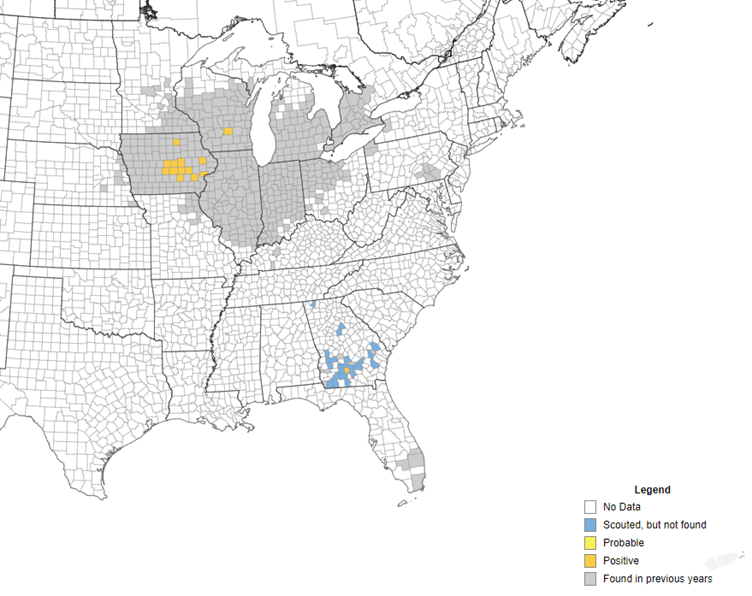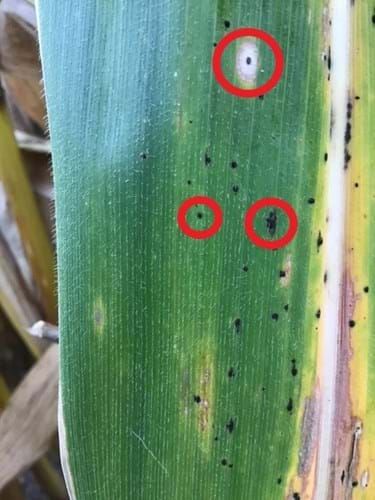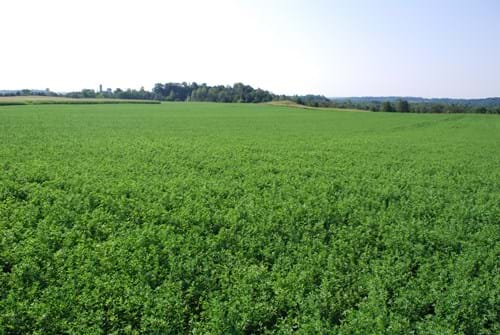Begin Scouting for Tar Spot; Fertility Needs for Alfalfa; Field Signs Available
BY Dairyland Seed Agronomy Team
TAR SPOT UPDATE
Although corn stages vary across the region, most of the corn is quickly approaching or entering the reproductive stages. As we have learned from previous years, corn is most susceptible to tar spot infection from about V10 – R5 (dent) growth stage so now is the time to start prioritizing scouting.
Favorable conditions for tar spot
Favorable environmental conditions for tar spot infestation and development are moderate temperatures (68-77°F), humid conditions (>75% relative humidity) with long periods of leaf wetness (>7 hours). Observations from previous years indicate that leaf wetness is the most conducive environmental factor. Like other corn disease, tar spot is able to produce several generations of spores and infect the crop multiple times in the same season. The map below shows the current and previous tar spot infections (https://corn.ipmpipe.org/tarspot/).

Tar spot scouting and identification
Target fields that are near or at tasseling and fields that have had tar spot in the past. It is important to note that not only does tar spot overwinter on infected residue, it is also spread by the wind. Therefore, if you have a field downwind of a heavily infected field that downwind field should also be labeled as a target field for scouting. When scouting fields be sure to look at the lower and mid-sections of the corn plant for lesions on the leaves. Tar spot lesions will be black and more or less circular with raised structures called stromata. These lesions may also be found on the upper and lower side of the leaves, stems and husks of affected corn plants. Be careful not to confuse tar spot with insect frass. Frass is often black and about the same size but frass will wipe off with a little moisture and rubbing, while tar spot will not. The pictures below show a corn leaf infected with tar spot.


Apps like Tarspotter and Field Prophet that use weather models to predict risk of infection are also very helpful to prioritize fields for scouting. These two apps are both available for Apple or Android devices and can be found below.
Tar Spotter- https://apps.apple.com/us/app/tarspotter/id1454584176
Field Prophet- https://www.fieldprophet.com/
Management Options
There are no corn hybrids with known resistance to tar spot but some hybrids are showing slight differences in susceptibility. With that being said, hybrid selection based on tolerance is the first line of defense. Crop rotation away from corn may help temporarily break the cycle but there are still a lot of unknowns. Fungicide applied at the VT (tassel) - R2 (blister) stage has shown the most consistent yield increase. The best fungicide results have been observed with products containing at least 2 MOA (modes of action). Specifically, Group 3 (Triazoles) and Group 11 (Strobilurins).
More information on the efficacy of specific products and harvest restrictions please consult the Fungicide Efficacy for Control of Corn Diseases Table https://cropprotectionnetwork.s3.amazonaws.com/CPN2011_FungicideEfficacyControlCornDiseases_04_2022-1650470887.pdf.
If you suspect tar spot, reach out to your local agronomist or university extension for a positive identification and more information.
THIRD CROP ALFALFA FERTILITY: PREPARE FOR WINTER
Second crop alfalfa has wrapped up in the last week and third crop is off to the races. We anticipate a few areas to already begin third crop harvest next week. A common fertility strategy for alfalfa is to split apply nutrients following first and third crop harvests. Why does this strategy work so well? First crop applications help fill in shortcomings from winter conditions and drive productivity through the current season. Maybe more importantly, the third crop application helps us finish strong and sets us up for a successful winter ahead.

The most important factor for alfalfa fertility is soil pH. It drives the availability of all other nutrients and greatly influences nitrogen fixation. Target 6.8-7.0 for the ideal soil pH. Lime applications take time to amend the soil, so remember that we are playing the long game here. Quick fixes are not effective.
Because of the sheer volume of demand, our next priority is potassium. An alfalfa crop removes 60 lbs of K2O per dry matter ton per year. A solid stand churning out 7 dry T/A in a year will be using 420 lbs of K2O. It can be hard to keep up! Phosphorous is usually in the same conversation as potassium, but at a removal rate of about a 15 lb P2O5 per dry matter ton per year, it is easier to maintain. Additionally, regular manure applications typically take care of phosphorous in alfalfa. Just keep an eye on soil tests to determine your true needs for both nutrients.
Sulfur is also a key need for most alfalfa stands. Elemental sulfur is removed from the soil at a rate of 5 lb per dry matter ton per year. Periodically adding 50 lbs/A of AMS to a potash application is the best way to cover these needs. Lastly, add 2 lb/A of boron once a year for good measure. This nutrient is very important for nutrient pathways and plant structure.
Now is a good time to reflect on how well you have kept up with the fertility needs of your crop. Be honest with yourself and don’t cut corners. Creating strong stands now will greatly increase our odds of successful winter survival.
SHOW OFF YOUR FIELDS WITH DAIRYLAND SEED FIELD SIGNS
Signing your fields is a great way to promote Dairyland Seed products in your area. Field signs for corn, soybeans and alfalfa can be ordered by calling the Dairyland Seed headquarters at 800-236-0163 and ask to speak with Stacy Hendricks, Cindy Flasch or Diana Siders.
 |
 |
 |
 |
 |
| Brian Weller Western Region 507.456.3034 |
Dan Ritter Central Region 219.863.0583 |
Branden Furseth Northern Region 608.513.4265 |
Mark Gibson Eastern Region 260.330.8968 |
Amanda Goffnett Eastern Region 989.400.3793 |
